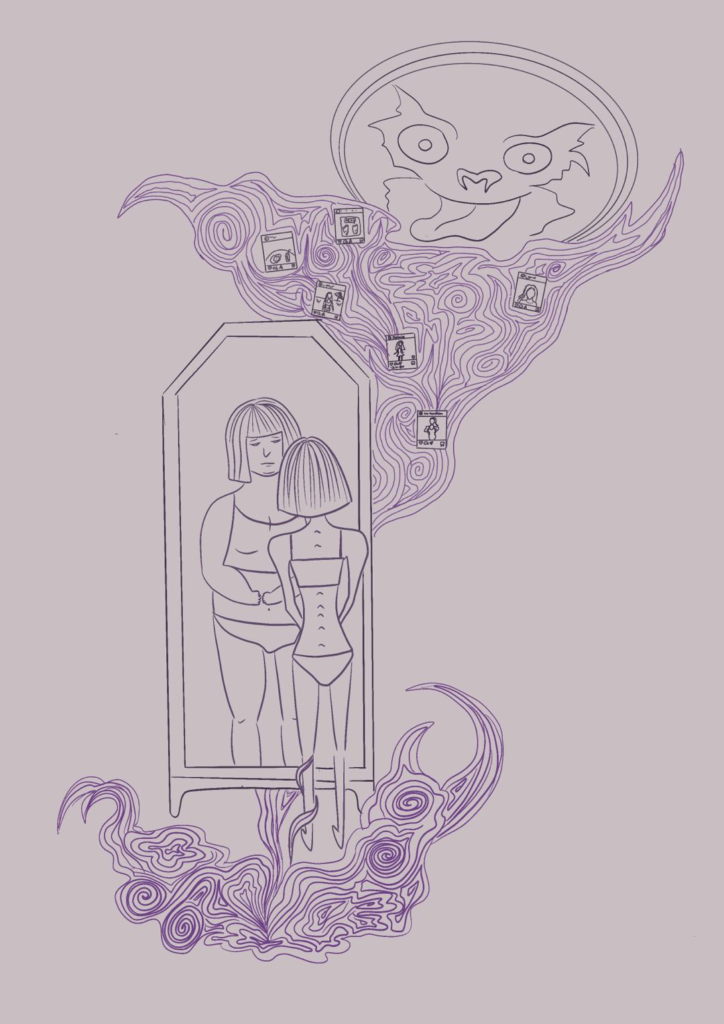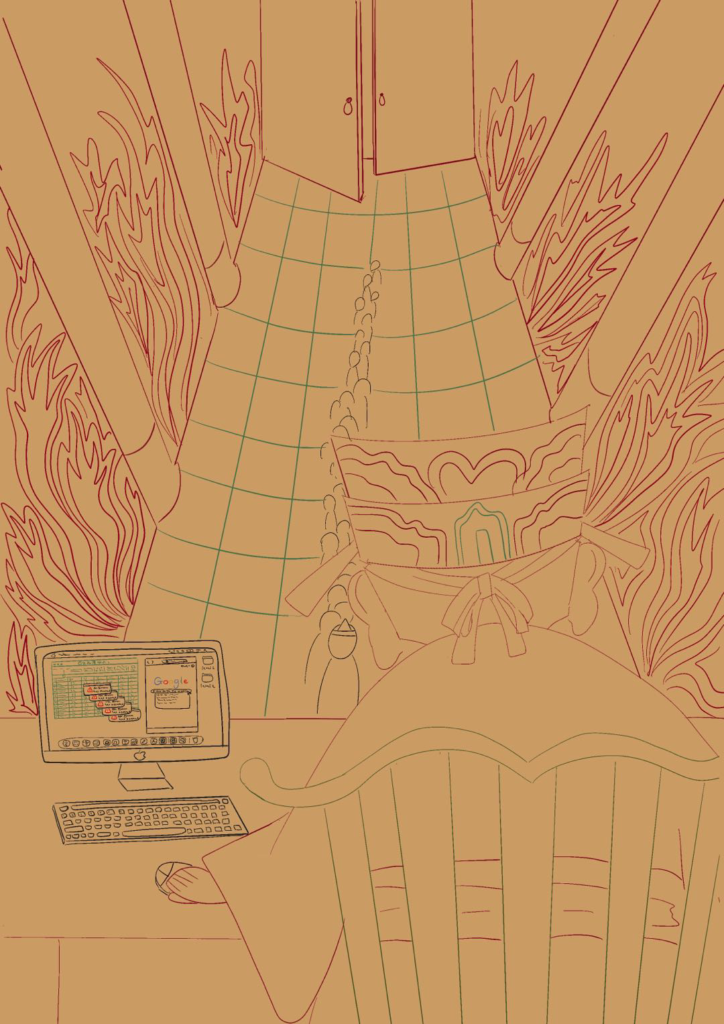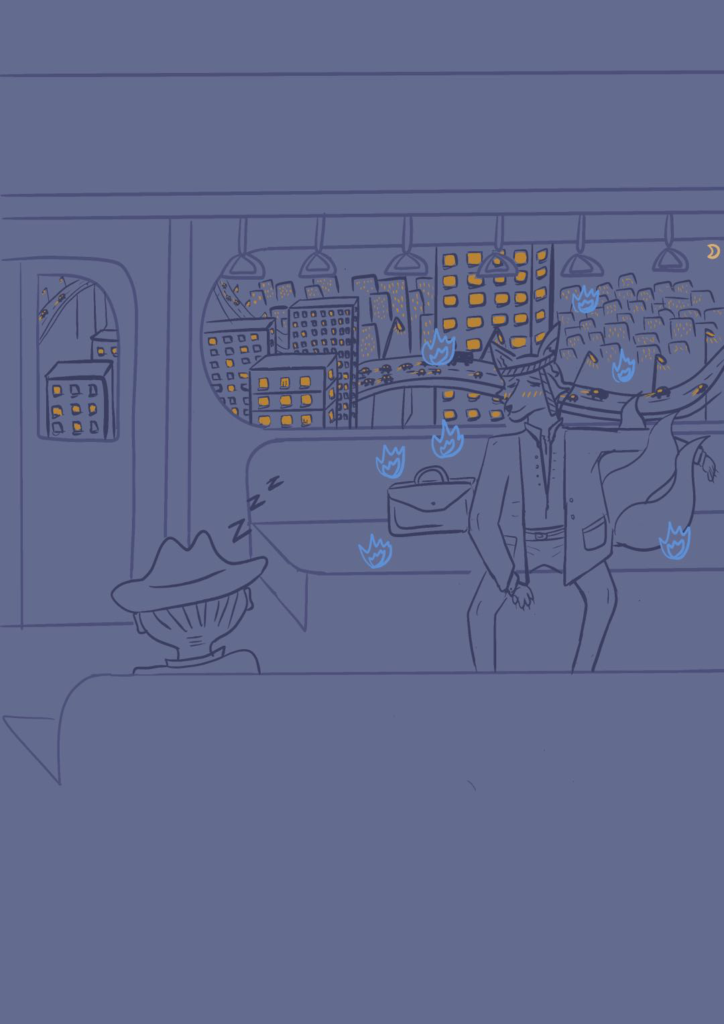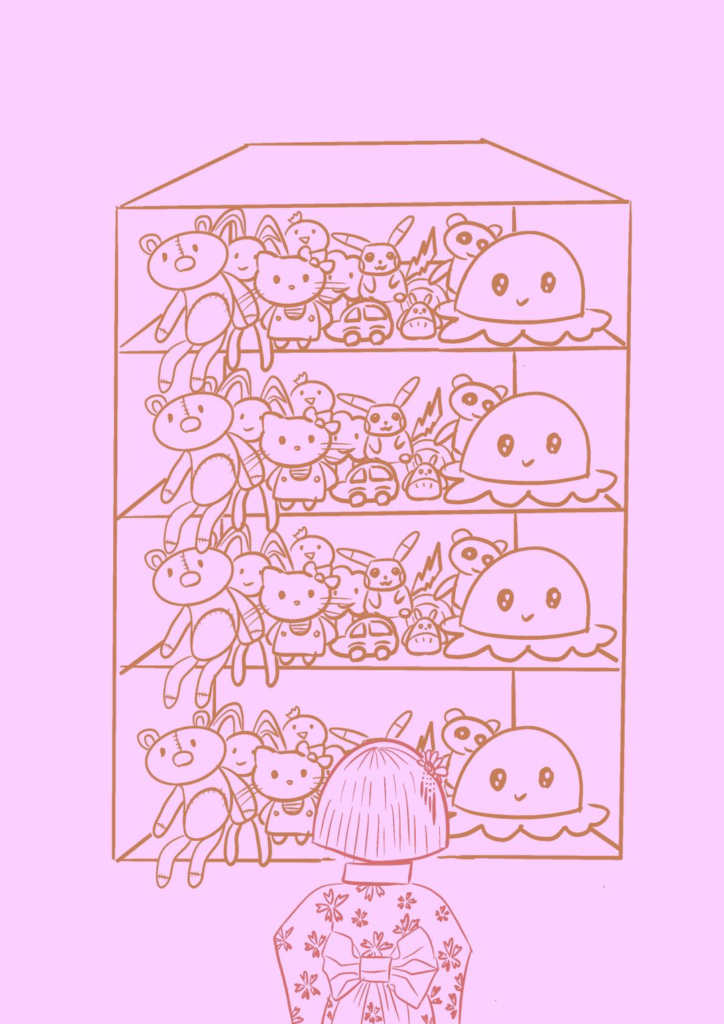Introduction:
The section explains how I got to the current project. Initially, the project was to create my yokai that incorporated elements with more traditional ones. My previous paper suggests that yokai were used to explain things people couldn’t understand in the past, one of which was sickness and illness.
As someone studying psychopathology for the semester, my first idea was to create yokai representing various mental illnesses. The most recent chapter I learned when beginning the project was about an eating disorder called anorexia nervosa, of which the patient is likely to experience seeing distorted body image. So the image——an extremely skinny girl standing in the mirror who sees herself as bulky——came into my mind. The mirror, then, would be my yokai, so I started to browse mirror yokai to see any previous records. I found out that a yokai called 雲外鏡 is present in traditional folktales, in which the yokai lets people appear demonized in the mirror. It turned out that I didn’t need to create the yokai for the anorexia nervosa idea, but it led me to think about how the traditional yokai may adapt to modern society.
Do they continue to exist in a technological-advanced context? Will they take on different habits? How should they blend into human societies now?
These are intriguing questions because they intended to test whether the reasons for creating some yokai are still applicable. Interestingly, my final take-away from the project shifted away from answering the research questions (again). While researching (or wanting to watch some of my favorite anime) for the drawing references with more modern yokai in anime and films from Ghibli Studio, I found a pattern. I realized many recent anime intend to convey the idea that human society and humans can be more vicious and cruel than yokai. I interpret it as projecting the creators’ fear of components of human society onto yokai. For instance, the film Pom Poko (Ghibli Studio) that inspired me to create サラリーマン狐 depicts the tanuki fighting back only because human construction takes away their mountain to build tall buildings. And the tanuki ends up losing the fight, and the softer party (v.s. the aggressive one) of the tanuki decide to transform into a human and fit into human society as a white-collar worker. Also, I believe that people (mostly female) become yokai because they were unfairly treated before death. So, yokai can also be a critique of the societal aspects as one projects the fear and anxiety into the narrative, which is what I eventually did with my project.
I) 雲外鏡
This piece is a bit different from the other three because it somewhat follows the initial plan for the project——describing mental illness using yokai. The undertone for this yokai is more negative as it is the active actor of the mischief here. In contrast, the other three yokai are the recipient (the projection of myself) of societal (human) pressure, so I portrayed them with more sarcastic humor. The general idea is explained in the previous section: the yokai makes the girl see herself as the most unwanted image in the mirror. For people who have anorexia nervosa, the worst thing they want to see is an image of themselves having gained any weight. They may still see themselves as “fat,” even when they are bony skinny. I do not have the condition but occasionally get anxious about my body image, as well. The critique falls on the toxic environment of social media where only the “perfect body” is seen. I believe it has developed into an increasingly dangerous social problem worldwide with more and more people hating their own bodies. So I incorporated Instagram posts from celebrities with the “good” body on the upper part of the smog the yokai generates. I also wanted the smog that appears to have rooted down the feet of the girl. Meanwhile, it almost resembles the web-like internet one could not escape.


II) エクセルにする閻魔帳
The piece intends to project my fear of data analysis. The hell king supposedly would use a hand-written book to check committed bad acts of the soul in the previous life to decide the kind of punishment to give. I thought it would be funny that the hell king keeps their records updated with Microsoft tools, such as excel. I intentionally referenced a version of the hell king who is bulky, leading to an interesting contrast with the tiny computer. The content on the screen is several warning windows being popped out saying that “an error has occurred,” suggesting that the hell king knows nothing about data analysis (just like me). The color selection of the floor is compatible with the excel form to contrast the way each soul standing on the floor is similar to the way their names and information will be pushed into the grid. In this way, I wished to criticize how data lacks the warmth and humanity people used to have. I also intended to be sarcastic about how all firms wish their applicants to know excel skills. I heard from the staff of the Gordon Career Center that many firms use AI to search for the keyword (e.g., excel) in resumes in the initial round of selection.
III) サラリーマン狐
Introduced a little in the introduction section, this piece is inspired by Pom Poko. I created サラリーマン狐 to project my fear of the pressure of being a salaryman, which is prominent not only in Japan but also in China. Foxes can transform into a human in the traditional Japanese yokai tales, like tanuki. I portrayed a fox salaryman who has to drink with his boss to make him happy after a day of work. I used the typical “tie over the head” motif, a common anime expression to suggest one is drunk. The fox gets drunk and accidentally turns back into his original form and has the foxfire around himself on the late-night subway. But it is alright because the only person (another salaryman) in the subway is sleeping. I wanted to have a dim tone in the subway but a bright background of the city, implying the social pressure of everyone feeling like they need to work restlessly.

fox salaryman

Zashiki-Warashi Needs to Compete
IV) 座敷童子の競争
Similarly, I aimed to criticize the intense, non-effective competition in society for jobs. Zashiki-Warashi is considered to be a good yokai who would bring luck to the house. It usually sits somewhere in the room. I intended to portray that Zashiki-Warashi couldn’t find a seat on the shelves as it is full of stuffed toys. It suggests that even a yokai could face failure in doing her job in the “labor market” she belongs to. I intentionally use the copy+paste function to present the shelves of toys to show the redundancy and lack of personality and diversity in some firms. Another way to interpret the redundancy of the stuffed toys is that I tried to criticize consumerism in our society. It was also a self-reflection on my shopping behavior as someone who has several teddy bears in my room.
Conclusion:
I believe that it was a successful, fun project to understand the reasons why people may want to create yokai. I eventually realized it was an intriguing way to laugh at my fears once I projected them onto yokai. I think one overarching theme of my project is the loss of warmth, life orientation, and willpower in a technological-advanced world.
Before carrying out the project, I didn’t know that I actually devalued some perspectives of technology (as I used to think of myself as more modern and a person of the city).
Additionally, expressing my ideas through drawing is an intriguing process that differs from writing an essay. Through the project, I learned that formulating one’s ideas into pictures may be more personal and reflective of the self. I can imagine that someone may write about a similar argument on yokai as mine, but I don’t think anyone will express it in the same way my drawings communicate.
